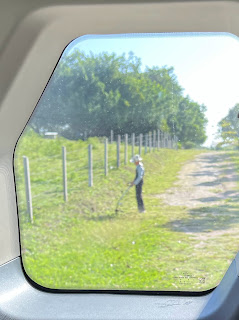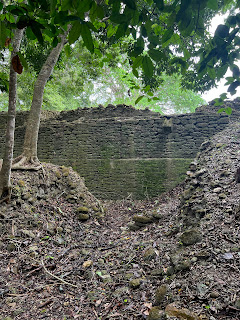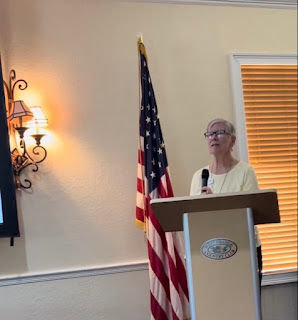Birding in Belize, February 2-12
We birded around the resort’s grounds, adding tropical mocking birds, melodious blackbirds, and rufous-tailed hummingbirds to my life list, if I kept one. Also at the resort were a group of English birders on tour and a bunch of Rotarians who’d come to build houses with a local chapter. Kathy, a long time Rotarian, introduced herself and us, and the poolside party began. I think the birders went to bed early to get an early start. We called it a day around 9:00; the Rotarians went to the bar for more fun.
Friday morning, we cruised the Belize River with maintenance man and birding guide extraordinaire Rudy. His eagle eyes and acute hearing helped us spot birds all along the river. Plus a small crocodile sunning on a log. Especially interesting were the proboscus bats clinging to the side of bridge pillows. They looked like globs of lichen.Since then, we spent 3 days at the La Milpa Ecolodge and Research Center, meeting at 6:00 AM for coffee and birding, breakfast, more birding, lunch, break, more birding, and dinner. One evening, we went out owling, seeing a barn and a mottled owl. I had forgotten how tiring having fun is. We’ve visited the Mayan ruin the University of Texas is excavating, although they haven’t been there for several years because of COVID.
Occasionally, even on the paved highways, there are official bumps, always marked, to prevent speeding. Seem superfluous to me.
The hummingbirds fed at the feeders hung under the roof. Very nice.
Monday, we drove 4 1/2 hours on limestone, pass Chan Chinch to Crystal Palace Resort near San Antonio. Our home for the next 3 nights, it’s fancier, with an honor system bar (we’d bought rum, some tonic, and beer at a local store but will need more tonic before we leave), and laundry. I’m beginning to be overwhelmed with all of the birds. I’ve decided to include in my list only the ones I’ve actually seen, not all the ones guide Glen has shown us, which flit in, then hide behind a branch.
Some are surprising, like the pigmy owl sitting on the top of of a tall cabbage palm stump in the center of a small town, Santa Elena, in the middle of the day. It was on our list to see, but we assumed we’d have to go out again at night.Others come to us, like the collared aricari which fed on the plantains hung at a feeder by the bar. They make huge hanging nests which they enter from the top.

By Thursday, I’d actually become more adept at zeroing in on the bird Glen pointed out. He shines a laser in the area, then tells what direction and how many feet away the bird is. Some, like the trogons (we’ve now seen all 5 species), sit nicely while I focus, others like the warblers, flit around and are hit or miss. When we were at the Mayan ruin of Laminai, the group searched for 20 minutes for an elusive ant wren. Past my attention span. I walked on.
The site at Caracole is being excavated by University of Central Florida. They have uncovered several large buildings. The rest will be opened up, studied, then re-covered to protect them from the elements and probably looters. Armed military guard the area, but what they are protecting are small palms which nearby locals illegally harvest for the flower trade. Bouquets I guess. Guatemala is just over the hill and has cut down all of its forest so they come to Belize for plants.
Kathy and I took a side staircase with a railing up to the middle level on the major temple, then ventured a short way up the next set of central steps. I was afraid to continue, but she went to the top of this level. Kyle, he of good knees and cardio, went all the way to the top of the fourth; the rest of our group watched from below. Evidently the Mayan priests ascended and descended the steps zigzagging back and forth to show off their magnificent headpieces. Not wanting to be a modern sacrifice, I scooted down on my butt. (If you zoom in, you can see Kathy, Glen, and me next to the center steps. Our beige pants and shirts match the stonework.)Agriculture (Mennonite and local), plus tourism are the major income producers in Belize. Lots of birding guides and resorts are all over the interior. Yet, we haven’t seen any gift shops or art galleries. I suspect they are at the coast with the beach resorts. Maybe birders are too cheap, although the tours are not. We met Robert who is on his way to seeing all species of the world’s eagles. He told us about an active ornate hawk-eagle’s nest near Black Rock Resort, so we changed our day’s plans to give it a go. Birding along local farmland with its trees by the fields, we saw lots and lots of birds.
The roads were lined with Mother of Cocoa trees in full bloom and with gumbo limbos whose berries attracted the birds. BTW, one can tell whether local or Mennonite farm by the fence lines. Mennonite take down everything at the field edges. No birding there.
Run out of Switzerland to Mexico, then on to Belize in the 1950’s, the Mennonites here range from conservative to very conservative. Some have electricity, others only propane and animal power. Solar seems to be making a small inroad. I saw a traditionally-clothed boy using a gas weed wacker.
The Shipyard Mennonites only use steel wheels on their tractors, rubber is forbidden. They can use rubber wheels on everything else. Why?
One, driven by two elementary aged boys, was packed with bags marked Belize sugar (there are lots of sugarcane fields), but Glen told us it was likely animal feed because the bags are recycled. I had wondered how a family could use 20 10# bags of sugar.
Each little ant carries a piece of leaf about the size of my big thumbnail. Over time, their coming and going completely removes any vegetation along the 6” wide paths they create. I asked Glen what plants they prefer, and he said, “The ones you like best.” Same as the iguanas in Florida.
At La Milpa, their mound was at least 8’ across.
Lots of butterflies similar to ours in Florida, and many pollinators, although I have seen few honey bees and no hives. Termite nests are in lots of trees and in the palapa (chikee hut) we ate lunch in.There are supposed to be morpho butterflies, but we haven’t seen any yet.
Thursday, we moved to the Bird’s Eye View Lodge on the island in Crooked Tree Lagoon, where our guide and his 8 siblings grew up. This area is very similar to south Florida with all the birds I know: ibis, snowy and cattle egrets, great blue, little blue, and green herons. There is also the agami heron which avoided us on our boat trip Friday morning.We have seen all five kingfishers species: belted, ringed, green, pygmy, and Amazon. All three jays: brown, green, and Yucatán. Also the 3 saltators, various warblers, peppershrikes, woodpeckers, tityra, falcons, etc. I’d downloaded a Belize bird app and can export a list of all the birds I saw (183) or heard (2). My favorite was the lesser yellow-headed vulture, much like our turkey vultures, but with a yellow head. I am thinking of trying to duplicate the “This is my carrion bag” I saw a few years ago at Tucker Preserve in California. For the group, the most desirable bird was the jabiru storks we saw in a rice field. At the airport, I bought jabiru salad tongs made of zericote wood, $50 Belize which is $25 US.
Saturday, our last birding day, we visited the Mayan ruin Lamanai. Several temples have been excavated, including one named the Jaguar because of the jaguar face built of stones on the facade either side of the bottom steps, a different technique than the usual carved ones. Another temple there is the only one found, so far, that was built, probably over 1000 years, as one building from start to finish. All the other Mayan temples are many layered, with each succeeding ruler having a new building built over the existing one, like frosting on a cake. When the Maya were here, all of the now grassy areas were stone plazas, covered in stucco and painted white, red, or blue. Certainly a different look than the green one we see. The ball courts have stone bleachers on the long sides and are much narrower that I’d imagined. Not regulation basketball sized.
The only rain of our trip cut our visit somewhat short, but truthfully, I was glad to get a little time off. Later that afternoon, we went out again in a pine area, I forget why. There were brand new jaguar prints in the roadway. We followed its footsteps for a while, but (un?)fortunately didn’t see it.
That evening Kathy, Lee and I went out to the street light and looked for common pauraques, a nighthawk type bird, that sit in the grass, then jump up and catch bugs. Two were working the area. I wonder if they eat the fireflies I saw earlier. Later we saw 5 lesser nighthawks flying across the street on their hunt for insects.

BUT, at Lamanai, we watched two monkeys fight, with the victor chasing the loser out of the tree, to the lagoon’s edge and out into the water. At first, we thought he was going to drown the other. Launa was really distressed and wanted her husband to stop the fight. I feared a monkey bite was in his future, but he held back. I guess thrashing in the water wore them out, because the howling stopped. The victor came ashore, and eventually so did the other. We weren’t sure if leadership had changed hands or not. Glen said he’d never, in his whole life, seen monkeys actually fight.
There are horses everywhere, not just with the Mennonites. The causeway to Crooked Tree was finished in 1981. Before that, supplies came by boat, and everyone used horses on the island, some ridden, some to pull carriages. Consequently, the houses are all on big lots to have room for the horses to graze. Now for the locals, they are nostalgia, or as Glen calls his 3, lawnmowers.
He speaks English, Spanish, and the local creole, which has a Jamaican sound.The truck says, “This is the chicken for us,” a call to the natural pride the locals have in their country.
I saw few cemeteries which I found odd. Perhaps they are tucked away from the road, unlike rural USA which has them everywhere. The ones I saw had concert vaults, often stacked one on top of the other, with no carvings that I could see from the van. I guess the families know who was buried where. At the Mayan ruins, there also wasn’t anything about burial areas. With the estimated 40,000+ inhabitants in most ancient cities, there surely was a specific way of dealing with the dead besides the few royals buried in the big temples. Perhaps the excavators on these sites just haven’t gotten that far.
The archeological student housing at La Milpa was almost the same, just with screens. We noticed camping hammocks hung in several, probably a good escape from bugs.
The food has been meh to almost good. Since we stayed at resorts, we were at their mercy, including boxed lunches that they provided. True, at each meal there was something interesting: salbutes (a mini tortilla with chicken and interesting spices), chayote and other veggies in a coconut milk sauce, sautéed snapper.
But mostly rather bland, probably for fear of guests’ reactions. Biscuits and muffins were over-handled and dense. Fry jack, i.e., puffs of dough fried, were usually pretty good. Cashew wine and jelly was godawful.
I tried a mango slushee with chamoyada powder that must be an acquired taste. Fresh papaya, banana, watermelon, pineapples, even cantaloupe were always good. Often the meals were too large, so I spoke to one kitchen staff and suggested they consider smaller portions with options of seconds. Of course I didn’t have to eat both biscuits they served me…
Sunday morning, a quick trip out for a last try at the rufous-browsed peppershrike before breakfast and trip to the airport. Success, but even better I think was the long look at a tiger heron as it grabbed a crawfish from a little pond and ate it. We’d seen several flying away, never one on the ground. The same trip yielded acorn woodpeckers with a fabulous stash of acorns which Glen told us they store to eat the grub that grows in each nut, rather than the nut itself. Who knew?
After the four of us are dropped off at the airport, Launa and Kyle will have one more outing since their flight is 2 hours after ours. It will be interesting to hear if they see something we didn’t. We’ve joked about seeing a harpy eagle (extremely unlikely), preferably with a howler monkey in its talons. But frankly, I don’t care. I’ve seen more than I could imagine. I tell myself I’m going to read up on the birds when I get home . Could be true.
This has been a wonderful trip. The birding was absolutely amazing, made possible by Glen, who could hear the call of the pygmy kingfisher as we drove by, then spot it in the vines. The weather was perfect, just a little warm the last few days, but cool most of the time, with no rain but once. However, the absolute best part has been the time we spent with longtime friends Kathy and Lee. I will treasure it.We parted ways at Miami as they head to Charlottesville, and we have our 6-hour layover in Miami. It’s Super Bowl Sunday, so we can watch and drink beer while we wait for our plane. We should arrive in Orlando about midnight, pick up our truck, and head for bed. The plan almost worked, except TGIFridays closed at 9:30. We knocked back our just-ordered 2nd round of beers, then moved to a gate which had the game on, even had closed captions. All good.I’m crossing my fingers that my bites are chiggers, not bedbugs. But just in case, we are leaving everything in the garage to be washed, and I’ve ordered insecticide which will arrive tomorrow so I can spray the suitcases before they come into the house.


















































Comments
Post a Comment